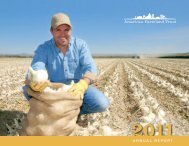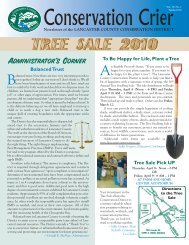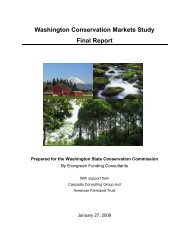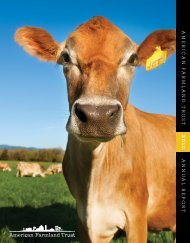Farms for the Future: Massachusetts - American Farmland Trust
Farms for the Future: Massachusetts - American Farmland Trust
Farms for the Future: Massachusetts - American Farmland Trust
You also want an ePaper? Increase the reach of your titles
YUMPU automatically turns print PDFs into web optimized ePapers that Google loves.
<strong>Farms</strong> <strong>for</strong> <strong>the</strong> <strong>Future</strong>Report annually on <strong>the</strong> Farm Viability Enhancement Program’s progress and undertakea comprehensive program evaluation.As with <strong>the</strong> APR program, <strong>the</strong>re is no regular report on <strong>the</strong> yearly milestones <strong>for</strong> <strong>the</strong> FVEPprogram nor has <strong>the</strong>re been a comprehensive evaluation of <strong>the</strong> program to date. Such anevaluation is especially needed as <strong>the</strong> MDAR begins to allow farmers to seek successive FVEPimplementation grants at <strong>the</strong> end of <strong>the</strong>ir initial grant term. An evaluation that quantifies <strong>the</strong>increases in sales, net income and employment on participating farms, as well as improvementsin productivity, technology and marketing could help to underscore <strong>the</strong> program’s benefits andprovide valuable perspective on program direction <strong>for</strong> <strong>the</strong> next 10 years.Encourage <strong>the</strong> transition of farms from <strong>the</strong> Farm Viability Enhancement Programto <strong>the</strong> Agricultural Preservation Restriction Program.Current policy discourages farmers who are participating in <strong>the</strong> FVEP from transitioning landinto <strong>the</strong> APR Program, by requiring farmers to reimburse <strong>the</strong> entire implementation grant when<strong>the</strong>y enroll land in <strong>the</strong> APR program, regardless of where <strong>the</strong>y may be in <strong>the</strong> length of <strong>the</strong>irFVEP contract. For example, a farmer who receives a $75,000 FVEP grant and signs a 10-yearno-development covenant on 100 acres of farmland must repay <strong>the</strong> entire $75,000 grant if, inyear seven, <strong>the</strong> farmer wishes to enroll those 100 acres in <strong>the</strong> APR program. A policy that prorates<strong>the</strong> required reimbursement to <strong>the</strong> length of time remaining in a FVEP contract—in <strong>the</strong>above example, $22,500 ra<strong>the</strong>r than $75,000—would encourage <strong>the</strong> transition of farmlandfrom one program to <strong>the</strong> o<strong>the</strong>r.Agricultural Environmental Enhancement ProgramInvest at least $1 million annually in <strong>the</strong> Agricultural EnvironmentalEnhancement Program.An investment of this size would require additional bond authority above <strong>the</strong> $3 millionprovided in <strong>the</strong> 2008 Environmental Bond, yet would serve to maximize <strong>the</strong> environmentalbenefits produced by <strong>the</strong> Commonwealth’s 518,000 acres of working farmland. Much as <strong>the</strong>Agricultural Conservation Planning Partnership, which funds <strong>the</strong> development of whole farmconservation plans, is comparable to <strong>the</strong> business planning phase of <strong>the</strong> FVEP, <strong>the</strong> AEEP is likePhase II of that program, funding <strong>the</strong> implementation of conservation plans. Unlike <strong>for</strong> farmbusiness plans, <strong>the</strong>re are significant federal resources available <strong>for</strong> conservation plan implementation.Funding <strong>for</strong> <strong>the</strong> federal Environmental Quality Incentives Program (EQIP)—thatprovides grants to farmers to implement on-farm energy, air, soil and water conservationpractices—is scheduled to ramp up over <strong>the</strong> next five years, and <strong>the</strong> Farm Bill’s “regionalequity” provision will help to ensure that some of that funding increase comes to <strong>Massachusetts</strong>.As EQIP generally requires a 25-50 percent cost-share, increased funding <strong>for</strong> AEEP should allow<strong>Massachusetts</strong> farmers to leverage significant new federal resources <strong>for</strong> practices that will leadto cleaner air and water and reduced water and energy use.18<strong>American</strong> <strong>Farmland</strong> <strong>Trust</strong>



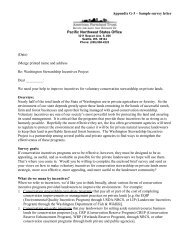

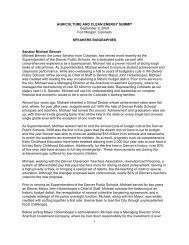
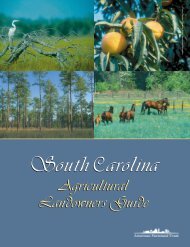
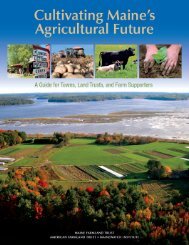
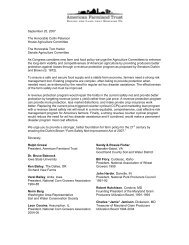
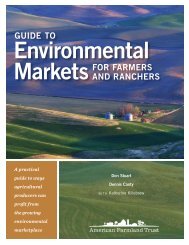
![Farmland by the Numbers [PDF] - American Farmland Trust](https://img.yumpu.com/31549391/1/190x245/farmland-by-the-numbers-pdf-american-farmland-trust.jpg?quality=85)
